全国英语教师教学设计大赛获奖作品—初中教案.docx
初中英语优秀获奖教案范文
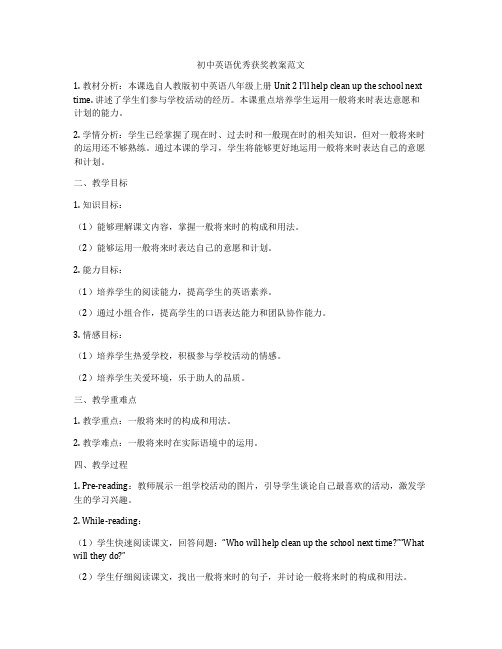
初中英语优秀获奖教案范文1. 教材分析:本课选自人教版初中英语八年级上册Unit 2 I'll help clean up the school next time. 讲述了学生们参与学校活动的经历。
本课重点培养学生运用一般将来时表达意愿和计划的能力。
2. 学情分析:学生已经掌握了现在时、过去时和一般现在时的相关知识,但对一般将来时的运用还不够熟练。
通过本课的学习,学生将能够更好地运用一般将来时表达自己的意愿和计划。
二、教学目标1. 知识目标:(1)能够理解课文内容,掌握一般将来时的构成和用法。
(2)能够运用一般将来时表达自己的意愿和计划。
2. 能力目标:(1)培养学生的阅读能力,提高学生的英语素养。
(2)通过小组合作,提高学生的口语表达能力和团队协作能力。
3. 情感目标:(1)培养学生热爱学校,积极参与学校活动的情感。
(2)培养学生关爱环境,乐于助人的品质。
三、教学重难点1. 教学重点:一般将来时的构成和用法。
2. 教学难点:一般将来时在实际语境中的运用。
四、教学过程1. Pre-reading:教师展示一组学校活动的图片,引导学生谈论自己最喜欢的活动,激发学生的学习兴趣。
2. While-reading:(1)学生快速阅读课文,回答问题:“Who will help clean up the school next time?”“What will they do?”(2)学生仔细阅读课文,找出一般将来时的句子,并讨论一般将来时的构成和用法。
3. Post-reading:(1)学生分角色朗读课文,提高口语表达能力。
(2)教师组织学生进行小组讨论,让学生运用一般将来时表达自己的意愿和计划。
4. Consolidation:(1)学生编写一篇关于学校活动的短文,运用一般将来时。
(2)学生进行角色扮演,表演自己的短文,展示小组合作成果。
五、教学评价1. 课堂参与度:观察学生在课堂上的发言和互动情况,评价学生的参与度。
初中英语教师基本功大赛一等奖教学设计

初中英语教师基本功大赛一等奖教学设计前言初中英语教师基本功大赛的一等奖教学设计是以提高教师教学能力和教学水平为目标,通过评估教师在教学设计方面的创新能力和实施能力。
本文档将介绍一份获得一等奖的初中英语教学设计。
教学目标- 通过本次教学,学生将能够掌握字母表的26个英文字母及其发音。
- 学生将能够通过音标准确地发音,并能辨别不同的音标。
- 学生将能够熟练地拼读简单的单词。
教学内容和步骤1. 引入:- 利用图片和实物引入英文字母的概念,激发学生的兴趣。
- 通过唱歌、游戏等方式,让学生熟悉英文字母的顺序和发音。
2. 研究字母表:- 呈现字母表,并带领学生齐读字母表。
- 教授字母表中每个字母的发音和写法,让学生模仿发音并跟读。
3. 研究音标:- 引入音标的概念,并解释其作用。
- 逐个教授英文元音音标和辅音音标,让学生模仿发音,并进行师生互动。
4. 组合音标与字母:- 将音标与字母相结合,教授带有音标的单词,并让学生跟读。
- 练读音标,让学生辨别音标并读出对应的单词。
5. 拼读简单单词:- 教授常见的简单单词,让学生掌握它们的发音和拼读。
- 调动学生积极性,设计有趣的拼读游戏,让学生进行口头和书写练。
6. 结束:- 进行小结,复本课所学内容。
- 结合实际情境,让学生应用所学的英文单词与句子进行表达。
教学评价1. 观察学生的参与程度和研究态度。
2. 通过小组讨论、问题回答等方式检测学生对研究内容的掌握情况。
3. 听取学生的自我评价,了解他们对课堂教学的反馈。
4. 设计简单的测试,检验学生对字母、音标和拼读的理解和掌握程度。
教学资源- 图片和实物- 字母表展示材料- 音标卡片- 单词卡片- 活动游戏材料结语以上便是获得初中英语教师基本功大赛一等奖的教学设计。
通过本次教学设计,学生将能够在轻松愉快的氛围中学习英文字母和音标,提高英语发音和拼读的能力。
同时,该设计注重互动和实践,能够激发学生的学习兴趣和参与度。
希望本设计能对广大初中英语教师的教学工作有所启发。
初中英语大赛优秀教案模板
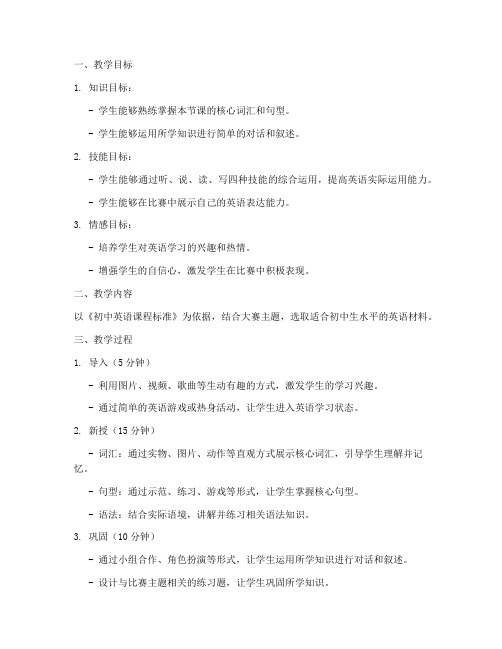
一、教学目标1. 知识目标:- 学生能够熟练掌握本节课的核心词汇和句型。
- 学生能够运用所学知识进行简单的对话和叙述。
2. 技能目标:- 学生能够通过听、说、读、写四种技能的综合运用,提高英语实际运用能力。
- 学生能够在比赛中展示自己的英语表达能力。
3. 情感目标:- 培养学生对英语学习的兴趣和热情。
- 增强学生的自信心,激发学生在比赛中积极表现。
二、教学内容以《初中英语课程标准》为依据,结合大赛主题,选取适合初中生水平的英语材料。
三、教学过程1. 导入(5分钟)- 利用图片、视频、歌曲等生动有趣的方式,激发学生的学习兴趣。
- 通过简单的英语游戏或热身活动,让学生进入英语学习状态。
2. 新授(15分钟)- 词汇:通过实物、图片、动作等直观方式展示核心词汇,引导学生理解并记忆。
- 句型:通过示范、练习、游戏等形式,让学生掌握核心句型。
- 语法:结合实际语境,讲解并练习相关语法知识。
3. 巩固(10分钟)- 通过小组合作、角色扮演等形式,让学生运用所学知识进行对话和叙述。
- 设计与比赛主题相关的练习题,让学生巩固所学知识。
4. 比赛准备(10分钟)- 指导学生如何准备比赛,包括演讲稿的撰写、语音语调的调整、肢体语言的运用等。
- 组织模拟比赛,让学生熟悉比赛流程,增强自信心。
5. 总结与反思(5分钟)- 对本节课的学习内容进行总结,强调重点和难点。
- 鼓励学生课后继续练习,为比赛做好准备。
四、教学评价1. 课堂表现:观察学生在课堂上的参与度、积极性、合作能力等。
2. 作业完成情况:检查学生对课堂知识的掌握程度。
3. 比赛表现:评估学生在比赛中的表现,包括语音、语调、内容、表达等方面。
五、教学反思1. 教学过程中是否激发了学生的学习兴趣?2. 学生是否掌握了本节课的核心知识?3. 教学方法是否适合学生的认知水平和学习风格?4. 如何改进教学,提高学生的学习效果?六、教学资源1. 课本、教学参考书2. 图片、视频、音频等教学素材3. 互联网资源,如英语学习网站、在线词典等七、教学注意事项1. 注重学生的个体差异,因材施教。
全国英语教师赛课一等奖英语七年级上册(人教2024年新编)《Unit3 SectionB》教学设计
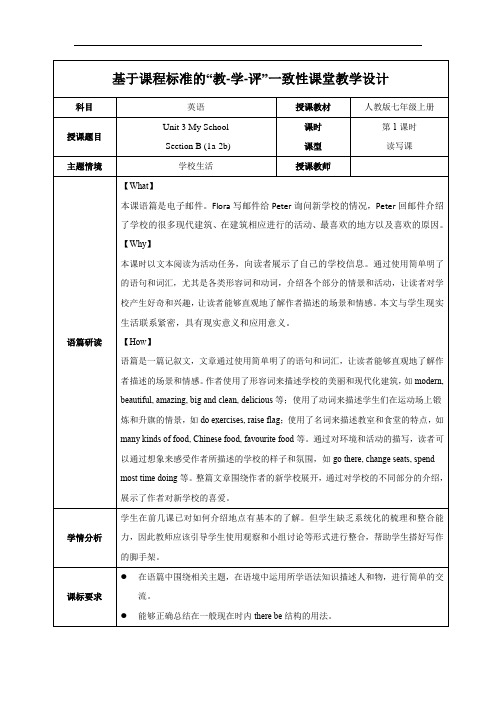
基于课程标准的“教-学-评”一致性课堂教学设计科目英语授课教材人教版七年级上册授课题目Unit 3 My SchoolSection B (1a-2b)课时课型第1课时读写课主题情境学校生活授课教师语篇研读【What】本课语篇是电子邮件。
Flora写邮件给Peter询问新学校的情况,Peter回邮件介绍了学校的很多现代建筑、在建筑相应进行的活动、最喜欢的地方以及喜欢的原因。
【Why】本课时以文本阅读为活动任务,向读者展示了自己的学校信息。
通过使用简单明了的语句和词汇,尤其是各类形容词和动词,介绍各个部分的情景和活动,让读者对学校产生好奇和兴趣,让读者能够直观地了解作者描述的场景和情感。
本文与学生现实生活联系紧密,具有现实意义和应用意义。
【How】语篇是一篇记叙文,文章通过使用简单明了的语句和词汇,让读者能够直观地了解作者描述的场景和情感。
作者使用了形容词来描述学校的美丽和现代化建筑,如modern, beautiful, amazing, big and clean, delicious等;使用了动词来描述学生们在运动场上锻炼和升旗的情景,如do exercises, raise flag;使用了名词来描述教室和食堂的特点,如many kinds of food, Chinese food, favourite food等。
通过对环境和活动的描写,读者可以通过想象来感受作者所描述的学校的样子和氛围,如go there, change seats, spend most time doing等。
整篇文章围绕作者的新学校展开,通过对学校的不同部分的介绍,展示了作者对新学校的喜爱。
学情分析学生在前几课已对如何介绍地点有基本的了解。
但学生缺乏系统化的梳理和整合能力,因此教师应该引导学生使用观察和小组讨论等形式进行整合,帮助学生搭好写作的脚手架。
课标要求●在语篇中围绕相关主题,在语境中运用所学语法知识描述人和物,进行简单的交流。
全国英语教师赛课一等奖人教版英语七年级上册(人教2024年)《Unit3 SectionA》教学设计

Topic Unit 3 My SchoolPeriod Section A What is your school like? 1a~1dTeaching Aims 1.Students can master the new words about school buildings.Eg: library, dining hall, gym, classroom building, art building, music hall...2.Students can understand the prepositions about the positions about theplaces. Eg: in front of, behind, between, across from, next to3.Students use the expression to ask places.Eg: Where is... ? / Is there ...?4.Students should improve their listening and speaking skill after this class.5.Students try to get familiar with the school and love the school more. Important points 1.New words about school building and positions about places.eful expressions to ask and answer locations.Difficult points 1.How to help students get confident in listening and speaking.2.How to motivate students’ love of the school or surroundings we live.Teaching proceduresActivitiesTwo weeks later, there will be our school’s opening day, then we will be volunteers to guide our parents and others to go around our school. So today we should learn something about our school well!1.Look and say: What are they?Show pictures about our school and learn the words about school buildings.※Sports field / playground/ campusSports field: a large area with specific parts for different sports. They are often marked with flags, white lines, or posts,Playground: an outdoor area where children can play, usually in a school or in public parks. “ playground” in the UK= “schoolyard” in the USCampus: is more common in the US but is used in the UK at universities or colleges of further education to refer to all the buildings and land that make up the institution.2.Look and say : Where are they?2.1Learn prepositions of positions about places.2.2Learn to express the location of the places.---- Where is the dining hall?---- It’s in front of the art building.3.Listen and learn: How to help new comers get to know our school3.1Listen to the conversations and number the places in the order you hear.3.2Listen again and complete the sentences.3.3Listen and learn the useful expressions about asking and answering location of places.----Where is ...? ---- It is ....---- Is there ...in this school? ---- Yes, there is./ No, there isn’t.3.4Conclude some spoken language in these conversations.► Offering help:Can I help you ? / What can I do for you? / Do you need any help?► Asking for help: It is important to be polite when asking strangers for help.Where’s the library? (impolite)Excuse me, could you tell me the way to the library?Excuse me, how do I get to the library?"Sorry to bother you. Can you tell me how to get to the library?Please could you help me? I’m looking for the library.► Expressing thanks:Thanks./ Thank you./ Thank you for your help.4.Pair work: Be familiar with our school well4.1Try to draw a map of our school and mark the school buildings.4.2Talk about their positions in pairs by using expressions:---- Where is ...? ---- It is ....---- Is there ...? Yes, there is. / No, there isn’t.Blackboard designUnit 3 My SchoolSection A What is your school like? ( 1a~ 1d)1.School buildings:library computer building classroom building school hall sports fieldplayground teachers' building shop science building art building dining hall gym music hall dormitory stadium student centre pondFountainin front of, behind, between, across from, next toeful expressions---- Where is the library?---- It is in front of the art building.---- Is there a library in this school?----Yes, there is. / No, there isn't.Topic Unit 3 My SchoolPeriod Section A What is your school like? (2a~2f)Teaching Aims 6.Students can master the new words about classroom objects.Eg: student desk, smart whiteboard, blackboard, lockers, ...7.Students can understand the prepositions about the positions about theplaces. Eg: in the middle of, at the back of, at the corner...8.Students use the expression to ask places.Eg: Where ... ? / Is there ...?/ There are ....9.Students should improve their listening and reading skill after this class.10.Students try to get familiar with the classroom and love the classroomand classmates more.Important points 3.New words about classroom objects and prepositions.eful expressions to ask and answer positions.Difficult points 3.How to help students get confident in listening and reading.4.How to motivate students’ love of the classroom where we study.Teaching proceduresActivities Justification1.Review school buildings in our school.school hall, gym, classroom building, teachers’ building...---- Where is the ...? ---- It’s ...---- Is there ...? Yes, there is. / No, there isn’t.2.Learn objects in the classroom.student desk, teacher's desk, whiteboard, blackboard, locker, drawer...---- Where is the ...? ---- It’s ...---- Is there ...? ----Yes, there is. / No, there isn’t.---- There are ....3.Listen and learn Peter’s introduction of his new classroom.Peter is a new comer to the school, and his mother wants to know something about his new classroom. Here is their conversation. Let’s learn Peter’s new classroom.3.1Listen twice and fill in the blanks.M: What’s your new classroom like, Peter?P: It’s large. There are 40 ______________ in the classroom. And a teacher's desk in front of the _________.M: Where do you sit?P: I sit ___________ the classroom.M: That’s nice. What’s ________ in your classroom?P: There’s a __________________ the blackboard. Oh, and there’s another_______________ at the back of the classroom.M: Another blackboard?P: Yes, we put up important _____________ there.M: Are there any ________ in the classroom?图片展示并复习复习整个教室图来学习教师物品及其陈设听力训练有两项任务:一是完成2a;二是完成左边练习。
全国英语教师赛课一等奖英语七年级上册(人教2024年新编)《Unit3 SectionA》教学设计
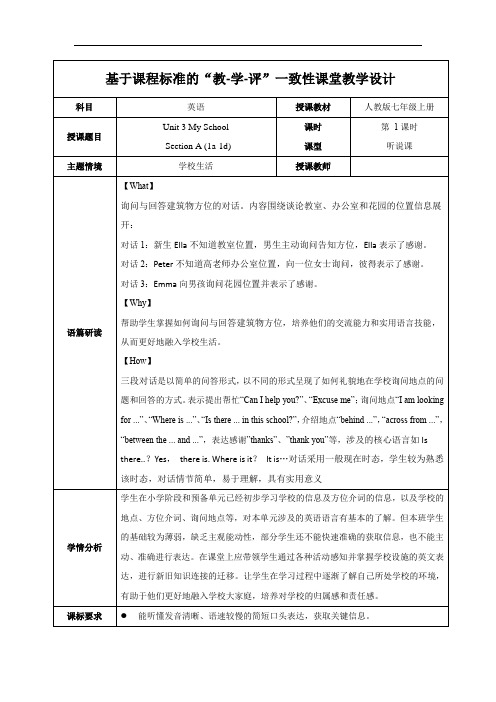
基于课程标准的“教-学-评”一致性课堂教学设计科目英语授课教材人教版七年级上册授课题目Unit 3 My SchoolSection A (1a-1d)课时课型第1课时听说课主题情境学校生活授课教师语篇研读【What】询问与回答建筑物方位的对话。
内容围绕谈论教室、办公室和花园的位置信息展开:对话1:新生Ella不知道教室位置,男生主动询问告知方位,Ella表示了感谢。
对话2:Peter不知道高老师办公室位置,向一位女士询问,彼得表示了感谢。
对话3:Emma向男孩询问花园位置并表示了感谢。
【Why】帮助学生掌握如何询问与回答建筑物方位,培养他们的交流能力和实用语言技能,从而更好地融入学校生活。
【How】三段对话是以简单的问答形式,以不同的形式呈现了如何礼貌地在学校询问地点的问题和回答的方式。
表示提出帮忙“Can I help you?”、“Excuse me”;询问地点“I am looking for ...”、“Where is ...”、“Is there ... in this school?”,介绍地点“behind ...”,“across from ...”,“between the ... and ...”,表达感谢”thanks”、”thank you”等,涉及的核心语言如Is there..?Yes,there is. Where is it?It is…对话采用一般现在时态,学生较为熟悉该时态,对话情节简单,易于理解,具有实用意义学情分析学生在小学阶段和预备单元已经初步学习学校的信息及方位介词的信息,以及学校的地点、方位介词、询问地点等,对本单元涉及的英语语言有基本的了解。
但本班学生的基础较为薄弱,缺乏主观能动性,部分学生还不能快速准确的获取信息,也不能主动、准确进行表达。
在课堂上应带领学生通过各种活动感知并掌握学校设施的英文表达,进行新旧知识连接的迁移。
让学生在学习过程中逐渐了解自己所处学校的环境,有助于他们更好地融入学校大家庭,培养对学校的归属感和责任感。
初中英语的优秀教学设计一等奖3篇

3、初中英语的优秀教学设计一等奖教学目标:1、知识目标本课时的四会单词2、能力目标1) 培养学生“听”、“说”的技能2) 能够在购物时正确使用英语教学重难点:1、“听”获取信息2、能够在购物时正确使用英语教学步骤:Part One: Pre-listeningT: Today let’s talk about pocket money、Do you have pocket money? How do you spend your pocket money? How about our friends Daniel, Simon, Sandy and Millie? How do they spend their pocket money? Let’s guess.Part Two: While-listening1、Listen and finish Part A.T: Please listen to the tape and finish Part A on page 84、Let’s check the answers.2、Listen and fill in the blanks.T: After listening, please fill in the blanks.3、Listen and write.T: Simon often spends money on football cards、What else does he like to buy?Ss: CDs, sports shoes, stationery and T-shirts.T: How often does he buy CDs?Ss: Sometimes.T: How often does he buy sports shoes, stationery and T-shirts? Please listen and answer.Ss: …Do poor children spend pocket money like Simon?Ss: No.T: Please look at the table on page 84、How often do poor children buy CDs?Ss: Never.T: How often do they buy sports shoes, stationery and T-shirts? Please listen again and write down the answers.Ss:…Part Three: Post-listeningT: Please read the advertisement on page 84 and complete the letter on page 85、Let’s read this letter together.Part Four: Speak up1、Listen and answer.T: We know Simon always spends his pocket money on football boots、Today he wants to buy a new pair、How much are the football boots? Please listen and think about this question.Ss: …2、Read and answer.T: Please read after the tape and think about these questions.Ss: …1、Read it in groups.2、Do an activity.T: Suppose you’d like to buy other things、Please work in groups of three and talk about the things in Part C2 on page 85、Use the dialogue in Part C1 as a model.家庭作业:1 Read the dialogue on page 85.2 Complete the following dialogue according to the Chinese sentences.王兰打算买一条尺寸为24号的牛仔裤,可试穿后发现有点小。
全国初中八年级英语优课大赛一等奖《Hometown Feelings》完美版教学设计

附件4基于思维能力发展的历史与社会话题阅读课学校:姓名:教材版本:人教版新目标教学年级:八年级课题名称:基于思维能力发展的历史与社会话题阅读课授课时间:2022年1月19日课型:阅读课(一)学情分析:学生掌握了七年级和八年级上册的内容,具有一定的词汇基础,能运用略读和精读策略读懂小短文,能用简单的语言描述自己或他人的经历,能发表简单的意见。
能尝试通过阅读和视听材料中提取信息,扩展知识。
能在学习中互相合作探讨。
但学生尚未接触完成时,故对时态的认识是模糊的。
(二)教材分析:Hometown Feelings这篇文章取材与人教新目标八年级下册Unit 10 I’ve had this bike for three years。
文章以外来务工人员为例,通过主人公钟伟对家乡变化与回忆的描述,表达了人们对家乡时时刻刻的关注与深深的眷恋,向读者传达思乡爱乡之情。
(三)教学目标1. 语言能力:学生能掌握among, search for, return, according to, change, development, opposite等单词,并能用于真实的语境中。
2. 思维品质:客观分析语篇内家乡的变与不变之间的内在关联,明确作者意图和情感,推断语篇的内在逻辑关系,从而带着逻辑性思维与批判性思维思考hometown feelings这个话题。
3. 文化品格:学生通过阅读了解城乡生活的变迁,培养学生对家乡的热爱之情。
4. 学习能力:学生能利用略读、精度等多种阅读策略有效阅读文本。
(四)教学重难点1. 教学重点:结合历史与社会背景,运用略读和精读把握文章主旨、内容和情感。
2. 教学难点:运用development、change、shame等新词汇表述家乡的变化和情感。
(五)教学策略:语篇阅读法、图式阅读法(六)教学媒体运用:黑板、电脑、PPT、视频、卡纸(七)教学过程1. 教学过程思维导图2. 教学过程(八)课堂实录Pre-readingStep 1. Look at the pictures and get the meaning of the topicT: Welcome to our English class today. Today I want to share my hometown feelings with you. Home sweet home. Home brings us happiness, so does our hometown. When we are not in our hometown, we may miss our hometown. Sometimes we feel homesick. Read after me. Hometown.Homesick.Ss:Hometown. Homesick.S tep 2. Listen to a story of the teacher’s hometown feelings and do a survey about students’ hometown.T: When I studied in a university in Chongqing. I was homesick. I missed my family,friends, and delicious food in Dongguan, and even the weather in Dongguan. I always told my mom I wanted to go back home. So I feel lucky to live in my hometown now. I want to do a little survey. Do you live in your hometown now? If you do, put up your hands.Ss( Some Students put up their hands)T:Let me count, one, two, three…, well, 13 of us in the hometown, but 33 students don’t live in the hometown. I want to know something more about your hometown. XXX, where is your hometown? How often do you go back to your hometown? Are you happy in your hometown? Ss: My hometown is…/Once/Twice a year/Yes.Step 3. Learn some new words from the stories about the Beijing drifters and Shenzhen drifters.T:People are happy in their hometown. But many people still leave their hometown. Look at the pictures, who are they?Ss:Dengchao and Fan Bingbing.T: Dengchao and Fan Bingbing are Beijing Drifters. Many years ago, they left their hometown and began to act in movies in Beijing. Now they’re famous actors. Kou Shishu is a Shenzhen drifter.20 years ago, he took 50 yuan to Shenzhen and now he is a boss of 7 factories.Step 4. Brain storm why people leave their hometowns.T: Now let’s think about it. Why do people l eave their hometowns? Discuss this question with your group members. From these drifters’ stories, what can you get?Ss:Because they want to have a better life/make more money/make their dream come true…While-readingStep 1. Skim the passage and find out the hero and the main idea of the passage.T:We have learned Dengchao’s story.Now let’s meet a new friend and learn his story. Let’s read the passage on P78 and find out “Who is the hero of the passage”, “What’s the passage mainly about? You’ll have two minutes. Now time’s up. Who wants to tell me who is the hero of the passage? XXX, pleaseS1: Zhong Wei.T: You did a good job. What’s the main idea of the passage? How about XXX?S2: The changes and his feelings of his hometown.S tep 2. Scan the passage and complete the mind map of Zhong Wei’s story.T: You can read the passage very quickly. Can you read the passage very carefully? Let’s read it again and complete the mind map of Zhong Wei’s story. Go ahead! You’ll have 5 minutes to do it. Have you finished. Let’s complete the mind map together. Who wants to be the first one to complete the mind map. XXX, please. Where does Zhong Wei live now?S1:WenzhouT: XXX, how long has he lived there?S2: 13 yearsT: Why does he leave his hometown?S3: To search for work.T;How often does he return to his hometown?S4: At least once a year.T: What changes may his hometown have?S5:Large hospital, new roads, new schools, teachers from the cities.T: What are his sweet memories of his hometown?S6: Children played together under the big tree.Step 3. Complete the summary of Zhong Wei’s story.T: Wow, you draw a mind map of Zhong Wei’s story. Very good. Why don’t we complete the summary of his story? Let’s have a try. You’’ll have four minutes to do it. Time’s up. Let’s finish the summary together. Many Chinese people…S:cities, hometown…T;L et’s read the summary again.S: Many Chinese people…Post-readingStep 1. Group discussion: If you are Zhong Wei, do you like the changes in your hometown? Why?T;As we can see, Zhong Wei thinks the changes in his hometown are good. What’s your idear? If you are Zhong Wei, do you like the changes in your hometown? Why? Discuss it with your group members.S s:…T: Who wants to share your idea with us?Ss: I like the changes because it makes our life better and better. /I don’t like the changes because it has broken our memories…S tep 2. Look at the picture and find out “What’s the symbol of Zhong Wei’s hometown?”T: We know something may change in our hometown. But something never changes in our hometown. Look at the picture and find out “What’s the symbol of Zhong Wei’s hometown?”Ss: The tree.S tep 3. Look at the pictures and watch a video, understand people’s love for their hometown. T: The tree means soft and sweet memories for Zhong Wei. Hometown so important for us that many people try their best to return home, especially on Spring Festival. Let’s watch about a video about how people return home.Ss( Watch the video and learn the love and importance of hometown)S tep 4. Group work: Look at the pictures and draw a mind map of your group’s hometown feelings.T: When people get home, they may find something has changed. Let’s look at the pictures. These are pictures about Changsha in 1990s, and these are Changsha in 2018...(Look at pictures about Chanagsha, Wuhan and Dongguan) Do you like the changes of Dongguan?Ss: Yes, /No…T: What do you think of Dongguan now? What do you think of your hometown now? Let’s share our hometown feelings with our group members. Let’s take out the paper and draw a mind map of our group’s hometown feelings. Go ahead. Discuss these questions with your classmates. You will have 10 minutes to do it.Ss (Discuss in a group and draw a mind map together)T: Hurry up. After finishing the mind map,every group put their mind maps on the blackboard and share your group’s idea with us.Ss:(Put up the mind map on the blackboard)T: Give big hands to yourselves. You did great! Which one is the best.S s:…T: Let’s invite them to make a report.Ss(Three groups make a report)T: East or west, home is the best. No matter what happened to our hometown, we still love our home.Step 5. Write a passage: My Beloved Hometown(九)板书设计(十)教学反思本节课以生动形象的图形开头,加以教师个人经历和社会热点,引起学生对家乡的情感共鸣,引导学生代入情境进行阅读。
第二届全国英语教师教学设计大赛参赛教案

第二届全国英语教师教学设计大赛参赛教案How’s the weather ?(七年级下Unit 6 Section B教案)四川省威远县第一初级中学黄正明组别:初中教案组Ⅰ.T eaching Aims and Demands1.Knowledge ObjectsKey Vocabulary:hot,cold,cool,warm,humid2.Ability ObjectsTrain students’listening skill.Train students’speaking skill 3.Moral ObjectDo in Rome as Romans do.Ⅱ.Teaching Key PointsThe key vocabulary. How,What questions.Ⅲ.Teaching DifficultiesTrain students’listening skill.Train students’speak ing skill Ⅳ.Teaching MethodsScene teaching method.Listening method.Pairwork.Ⅴ.Teaching AidsSlides showing hot,cold,warm,humid.Pictures .A tape recorder. Ⅵ.Teaching ProceduresStep ⅠRevisionBrainstorm students with questions How’s it going?and How’s the weather so that they can have a review of the words and target language learned in the previous classes.Step Ⅱ1aBefore class make slides showing hot,cold,cool,warm andhumid from the Internet ,magazines or newspapers. Now turn on “My Computer”,left c lick Flash H Show the slides in turn,teach students to practice the words hot ,cold,cool,warm and humid.Write the words on the blackboard.Show the pictures to the students.Point to the words randomly.Each time he or she finds a picture to go with a word,he or she has to say the word. Call students’attention to the pictures in the book.Ask students to tell what the weather is like in each picture using the words learned just now.For example,for Picture a,a student may say,it’s cold.Point out the numbered list of words in the box.Invite a student to read them aloud to the class.Say,please match the words with the pictures.Write the letter of each picture in front of the word it goes with.Point out the sample answers.Students finish the task individually.Check the answers.Answers1.d2.a3.e4.b5.cStep Ⅲ1bCall attention to the conversation in the speech bubbles.Invite a pair of students to read it to the class.Write the conversation on the blackboard.Say, Now let’s work in pairs. Start by reading the s ample conversation .Then ask and answer questions about the weather in the pictures in activity 1a.Students work in pairs. As the pairs are workingtogether ,move around the classroom listening and offering assistance if needed. Ask several pairs to present their conversations to the class.(This activity provides oral practice using the target language.) Step Ⅳ2aDraw attention to the chart. Read the names Maria and Sam and the headline. How’s it going ?to the class.Say ,I’ll play a recording of the conv ersation .Listen carefully and write down the answers Maria and Sam give to the question How’s it going?Play the recording twice .Students listen and write down the answers the second time they hear it.Check the answers.AnswersMaria :pretty goodSam: greatTapescriptMaria: Hello, Sam ?Sam: Maria? Hi! Where are you?Maria: I’m in Mexico !I’m calling to say happy birthday! Sam: Oh, thanks!Maria: So, how’s it going there?Sam :Great! How’s it going with you?Maria: Pretty good. What are you doing?Sam:I’m having a party .My whole family is here.Maria:Oh,that sounds like fun.How’s the weather?Sam: Terrible .It’s cold and raining .How’s the weather there? Maria:Hot.Hot and humid,and sunny.Sam: Sounds good…Maria: Uh-huh.Sam: So, what are you doing in Mexico?Maria: I’m visiting my grandmother…(This activity provides listening and writing practice using the target language.)Step Ⅴ2bTell students to look at the chart again.Read the headlines what are you doing? and how’s the weather ?to the class.Say,I’ll play the same recording once more.This time you are to listen and write down the answers Maria and Sam give to the questions what are you doing?and How’s the weather?Play the recording at least twice and use the pause button .Students listen and write down the answers in the chart.Check the answers.AnswersMaria: I’m visiting my grandmother .It’s hot, humid and sunny.(This activity provides listening and writing practice using the target language.)Step Ⅵ2cSay, you are asked to role play conversations between Maria and Sam in pairs.Suppose one is Maria and the other is Sam .Take turns asking each other the questions how’s it going ?What are you doing? and How’s the weather ?You may use the information in the chart in activity 2a.Invite two more advanced students to demonstrate a conversation to the class if necessary.Get students to role play conversations .The teacher writes a sample conversation on the blackboard so that students may use it as a model .Afterthat ,move around the room offering language support as necessary .Ask one or two pairs to share their conversations with the class.(This activity provides listening and speaking practice using the target language.)Step ⅦsummarySay,in this class we’ve learned another five words describing the weather, which are hot ,cold ,cool ,warm and humid .Then we’ve done much listening and oral practice using the target language on the blackboard.Step ⅧhomeworkMake up sentences with the words describing the weather each.Step ⅨBlackboard Des ign。
全国英语教师赛课一等奖人教版英语七年级上册(人教2024年)《Unit3-SectionB》教学设计
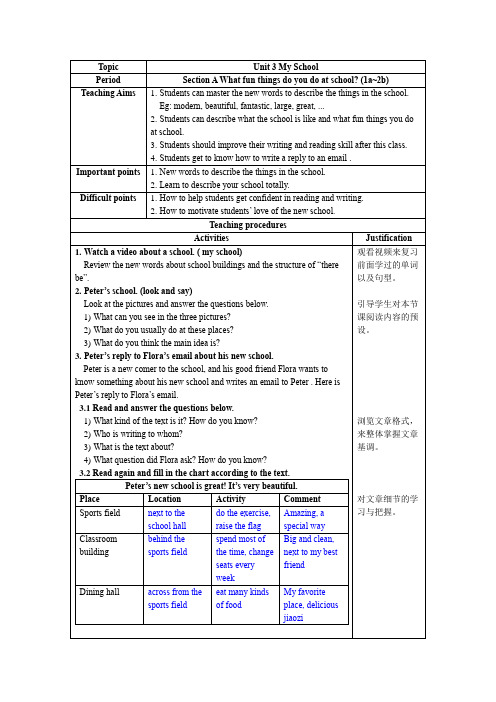
Topic Unit 3 My SchoolPeriod Section A What fun things do you do at school? (1a~2b) Teaching Aims 1.Students can master the new words to describe the things in the school.Eg: modern, beautiful, fantastic, large, great, ...2.Students can describe what the school is like and what fun things you doat school.3.Students should improve their writing and reading skill after this class.4.Students get to know how to write a reply to an email .Important points 1.New words to describe the things in the school.2.Learn to describe your school totally.Difficult points 1.How to help students get confident in reading and writing.2.How to motivate students’ love of the new school.Teaching proceduresActivities Justification 1.Watch a video about a school. ( my school)Review the new words about school buildings and the structure of “therebe”.2.Peter’s school. (look and say)Look at the pictures and answer the questions below.1)What can you see in the three pictures?2)What do you usually do at these places?3)What do you think the main idea is?3.Peter’s reply to Flora’s email about his new school.Peter is a new comer to the school, and his good friend Flora wants toknow something about his new school and writes an email to Peter . Here isPeter’s reply to Flora’s email.3.1Read and answer the questions below.1)What kind of the text is it? How do you know?2)Who is writing to whom?3)What is the text about?4)What question did Flora ask? How do you know?3.2Read again and fill in the chart according to the text.Peter’s new school is great! It’s very beautiful.Place Location Activity CommentSports field next to theschool hall do the exercise,raise the flagAmazing, aspecial wayClassroom building behind thesports fieldspend most ofthe time, changeseats everyweekBig and clean,next to my bestfriendDining hall across from thesports field eat many kindsof foodMy favoriteplace, deliciousjiaozi观看视频来复习前面学过的单词以及句型。
全国英语教师教学设计大赛获奖作品—初中精品教案
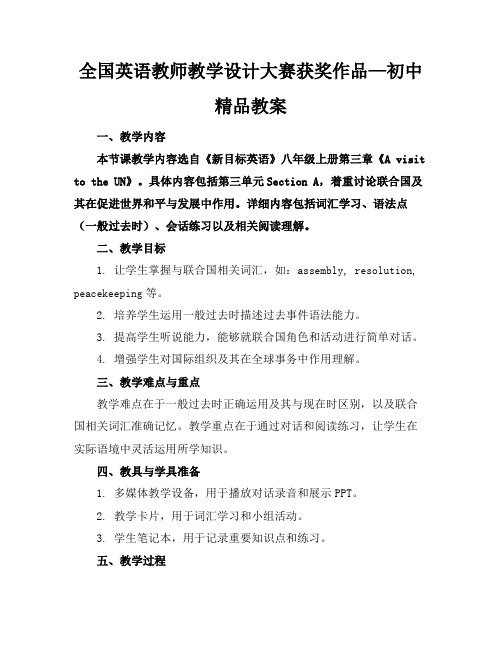
全国英语教师教学设计大赛获奖作品—初中精品教案一、教学内容本节课教学内容选自《新目标英语》八年级上册第三章《A visit to the UN》。
具体内容包括第三单元Section A,着重讨论联合国及其在促进世界和平与发展中作用。
详细内容包括词汇学习、语法点(一般过去时)、会话练习以及相关阅读理解。
二、教学目标1. 让学生掌握与联合国相关词汇,如:assembly, resolution, peacekeeping等。
2. 培养学生运用一般过去时描述过去事件语法能力。
3. 提高学生听说能力,能够就联合国角色和活动进行简单对话。
4. 增强学生对国际组织及其在全球事务中作用理解。
三、教学难点与重点教学难点在于一般过去时正确运用及其与现在时区别,以及联合国相关词汇准确记忆。
教学重点在于通过对话和阅读练习,让学生在实际语境中灵活运用所学知识。
四、教具与学具准备1. 多媒体教学设备,用于播放对话录音和展示PPT。
2. 教学卡片,用于词汇学习和小组活动。
3. 学生笔记本,用于记录重要知识点和练习。
五、教学过程1. 导入新课:通过展示联合国图片,引发学生思考其在国际事务中作用,自然引入新课。
小组讨论:让学生探讨联合国标志意义。
录音播放:听一段关于联合国工作对话,让学生预测对话内容。
2. 新知呈现:词汇教学:通过PPT展示和教学卡片,讲解并让学生练习新词汇。
语法讲解:以对话为例,讲解一般过去时用法。
3. 例题讲解:展示例题,解释一般过去时构造和应用。
让学生模仿例题,进行句子构造练习。
4. 随堂练习:分组对话练习:学生模拟联合国会议,进行角色扮演。
个人阅读理解:完成关于联合国阅读理解练习。
5. 巩固拓展:对话复述:学生复述所听对话,巩固词汇和语法。
角色扮演:学生模拟联合国代表,讨论国际问题。
六、板书设计板书将包括:1. 新词汇及其翻译。
2. 一般过去时构造和示例句子。
3. 联合国主要职能和活动。
七、作业设计1. 作业题目:编写一段关于联合国某次重要活动报道,至少包含5个新学词汇和一般过去时正确使用。
全国英语教师教学设计大赛获奖作品—初中优质教案2
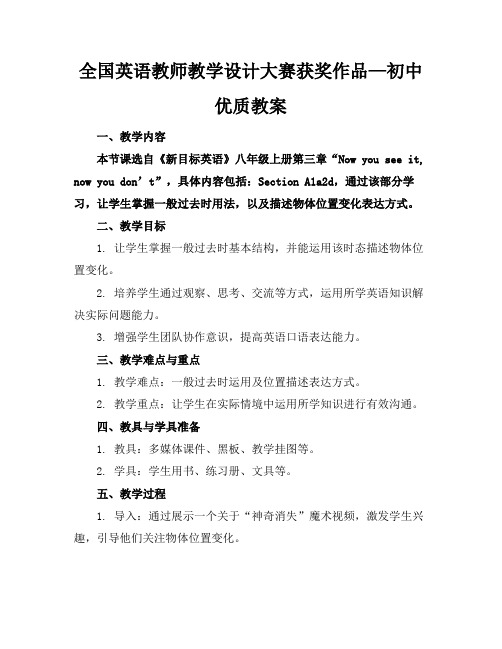
全国英语教师教学设计大赛获奖作品—初中优质教案一、教学内容本节课选自《新目标英语》八年级上册第三章“Now you see it, now you don’t”,具体内容包括:Section A1a2d,通过该部分学习,让学生掌握一般过去时用法,以及描述物体位置变化表达方式。
二、教学目标1. 让学生掌握一般过去时基本结构,并能运用该时态描述物体位置变化。
2. 培养学生通过观察、思考、交流等方式,运用所学英语知识解决实际问题能力。
3. 增强学生团队协作意识,提高英语口语表达能力。
三、教学难点与重点1. 教学难点:一般过去时运用及位置描述表达方式。
2. 教学重点:让学生在实际情境中运用所学知识进行有效沟通。
四、教具与学具准备1. 教具:多媒体课件、黑板、教学挂图等。
2. 学具:学生用书、练习册、文具等。
五、教学过程1. 导入:通过展示一个关于“神奇消失”魔术视频,激发学生兴趣,引导他们关注物体位置变化。
2. 呈现:呈现本节课主题,讲解一般过去时用法,让学生通过观察、思考、交流等方式,学会描述物体位置变化。
3. 讲解:结合教材内容,详细讲解一般过去时结构,以及位置描述表达方式。
4. 实践:设计小组活动,让学生用一般过去时描述物体位置变化,提高他们实际运用能力。
5. 巩固:进行随堂练习,检查学生对知识掌握情况,并及时进行反馈。
6. 作业布置:布置相关课后作业,巩固所学知识。
六、板书设计1. 板书主题:Now you see it, now you don’t!2. 内容:一般过去时结构:主语+动词过去式+其他描述物体位置变化表达方式:It was in/on/under七、作业设计1. 作业题目:(1)用一般过去时描述下列物体位置变化:a. The book was on the table, but now it’s on the chair.b. The keys were in the drawer, but now they are on the desk.(2)编写一段对话,描述你和你朋友在公园里玩捉迷藏游戏,运用一般过去时描述你们位置变化。
英语国赛教案模板范文初中
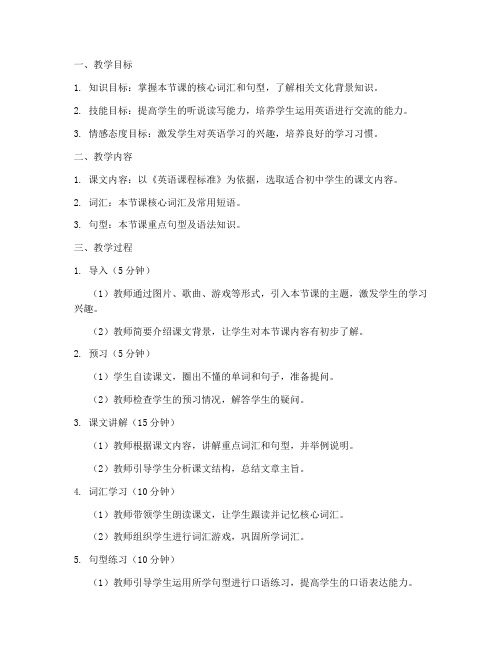
一、教学目标1. 知识目标:掌握本节课的核心词汇和句型,了解相关文化背景知识。
2. 技能目标:提高学生的听说读写能力,培养学生运用英语进行交流的能力。
3. 情感态度目标:激发学生对英语学习的兴趣,培养良好的学习习惯。
二、教学内容1. 课文内容:以《英语课程标准》为依据,选取适合初中学生的课文内容。
2. 词汇:本节课核心词汇及常用短语。
3. 句型:本节课重点句型及语法知识。
三、教学过程1. 导入(5分钟)(1)教师通过图片、歌曲、游戏等形式,引入本节课的主题,激发学生的学习兴趣。
(2)教师简要介绍课文背景,让学生对本节课内容有初步了解。
2. 预习(5分钟)(1)学生自读课文,圈出不懂的单词和句子,准备提问。
(2)教师检查学生的预习情况,解答学生的疑问。
3. 课文讲解(15分钟)(1)教师根据课文内容,讲解重点词汇和句型,并举例说明。
(2)教师引导学生分析课文结构,总结文章主旨。
4. 词汇学习(10分钟)(1)教师带领学生朗读课文,让学生跟读并记忆核心词汇。
(2)教师组织学生进行词汇游戏,巩固所学词汇。
5. 句型练习(10分钟)(1)教师引导学生运用所学句型进行口语练习,提高学生的口语表达能力。
(2)教师组织学生进行角色扮演,让学生在情景中运用所学知识。
6. 语法讲解(5分钟)(1)教师讲解本节课的语法知识,并结合实例进行讲解。
(2)学生进行语法练习,巩固所学知识。
7. 课堂小结(5分钟)(1)教师对本节课所学内容进行总结,强调重点知识。
(2)学生回顾所学内容,提出自己的疑问。
8. 作业布置(3分钟)(1)教师布置课后作业,包括词汇记忆、句型练习、课文背诵等。
(2)学生认真完成作业,巩固所学知识。
四、教学评价1. 课堂表现:观察学生在课堂上的参与度、口语表达能力、学习态度等。
2. 作业完成情况:检查学生的课后作业,了解学生对本节课知识的掌握程度。
3. 期末考试成绩:通过期中、期末考试,检验学生对本学期所学知识的掌握情况。
第三届全国英语教师教学设计大赛获奖作品——初中教案毛筠

教学过程教学反思本节课我主要想探讨新课标下如何注重学生的学习过程并进行有效的句型教学。
根据新课标初中英语听说、阅读与写作教学的现状,为了进一步提高教学的针对性和效果,我在英语教学中开始摸索将听说、阅读与写作教学作为一个整体来考虑,将阅读与写作教学中行之有效的各种方法进行优化组合,形成听说、阅读与写作联动的教学方法。
《新概念英语》的作者认为:“不写没有读过的语言,不读没有说过的语言,不说没有听过的话。
”我所实验的联动教学法的核心内容是:以听说为基础,以阅读材料为指导,并将它们作为写作的基础。
同时,还能将写作教学的效果---学生习作,作为对学生学习效果的一种检验,从而达到听说教学、阅读教学与写作教学的联动,促进学生英语综合能力的提高。
本节课我以激发学生兴趣为前提,鼓励学生大胆地使用英语;创设各种情景,使学生在掌握最基本的知识的同时,注意拓宽知识面,关注全体学生的学习情况,给他们自主学习和在真实的情景中,直接交流的自我发展空间;鼓励学生通过体验、实践等方式,发展听、说、读、写的综合能力;加强了对学生学习策略的指导,让他们在学习和使用的过程中逐步学会如何运用所学语言;关注学生情感,保护他们的自尊心和积极性,努力创造宽松民主、和谐的教学气氛。
一、本课的亮点分析1、教学目标设计突出了一个“明”字,即明确具体。
符合新课程标准的要求,以人的发展为本。
教学目标不但考虑了语言知识学习技能的培养,而且也考虑到了文化和情感教育。
2、教学过程设计突出了一个“清”字,即层次清楚。
教学结构严谨、环环相扣,过渡自然,时间分配合理,密度适中,效率高。
教学过程的主线非常清晰,明线是听(语言输入)→说(语言输出);读(语言输入)→写(语言输出),教学过程呈螺旋式上升,有梯度和一定厚度;暗线是(语言知识的学习和运用)词—句—文,重视语言学习的过程与运用。
3、PPT和flash的制作针对性强,能比较直观的启发学生思考,节约了课堂时间,提高了学习效率,加大了课堂密度。
全国英语教学设计一等奖

Lesson Plan for Around Our School 杭州外国语学校谢慧萍给Anne的回信——第七届全国中学(初中)英语教学观摩课说课杭州外国语学校谢慧萍《剑桥中学英语》采用全新任务型教学与生动的交互式学习模式;注重多学科的融通与多元文化的融合;注重学生听、说、读、写能力全面提高。
这些特色都很好地体现了国家《英语课程标准》所倡导的诸多最新理念。
第一册第三单元的教材设计充分体现了这些特点。
它以“Around Our School”为话题,通过书信这个形式,帮助学生学习、掌握用英语表达方位的能力。
本节课的教学对象是刚刚进入初二阶段的学生。
他们已经具备理解简单语篇、表达简单内容的能力,在英语语言知识方面,他们已经掌握大约500的词汇,也能使用完整的简单句和一般现在时态。
但他们的认知能力、语言能力、语用能力等尚处于初一下水平。
基于上述教材与学生的特点,本节课设计的中心任务是给Anne回信。
这个任务涉及的语言、技能、策略、情感、文化等五个方面教学内容贯穿整个课堂教学活动。
学生在教师的引导下,通过自主、合作等学习活动,综合操练、实践体验、真实运用,最终达到以下教学目标:1.语言目标这阶段的学生基本具备用简单的英语词汇与句型描述周边环境的能力。
但是,对于某些具体方位的正确描述,仍存在一定困难。
因此,本节课的语言目标定位在两个方面:一是学生学会在具体的语言环境下使用“in thenorth/south/east/west of…、flat、cafe”等词语;二是综合使用此类功能语言,准确描述自己学校校园的环境。
这个目标是完成中心任务的语言保证。
2.技能目标本堂课的语言技能定位在阅读技能的培养。
初二上的学生已经能够读懂一些简单语篇的主要信息。
在此基础上,本课进一步强化学生read for information的能力。
这种能力将会直接影响到本课中心任务的完成质量。
因为写回信首先要读懂来信。
3.策略目标学习策略的培养是提高学习效果的前提,又是需要在学习活动中得到体验的。
初中英语一等奖教学设计

初中英语一等奖教学设计《初中英语一等奖教学设计》这是优秀的教学设计一等奖文章,希望可以对您的学习工作中带来帮助!第1篇初中英语一等奖教学设计作为一名专为他人授业解惑的人民教师,常常需要准备教案,教案是教学活动的总的组织纲领和行动方案。
那要怎么写好教案呢?下面是小编整理的初中英语万能教案,供大家参考借鉴,希望可以帮助到有需要的朋友。
一、知识与技能1、掌握重点句型:How was your vacation?Where did you go? Did you go out with anyone?2、理解并掌握几个不定代词:anyone, everyone, something, anything, everything, nothing的用法。
3、熟练运用句型:Did you …?二、过程与方法学生通过上一节课的学习,对where引导的过去时态的特殊疑问句已经掌握,能自然地与本课知识相衔接。
让学生回忆他们的假期情况,引出一般过去时态的`句型,并且进行大量练习。
采用学生提出问题,学生解决问题,借助多媒体来提高学生的主动性。
三、情感、态度与价值观教育学生渗透合作精神和社会公德意识。
教学重点掌握句型:Where did you go on vacation? Did you go out with anyone? Did you buy anything? Did you visit anyone?教学难点能用句型Did you …?提出尽可能多的有关过去假期的问题。
教法导航创设情境,让学生自己总结规律,思考,讨论,最后得出结论。
创设英语语言氛围,使学生能较快地融入到英语语言学习的情景中来。
学法导航自主学习,独立思考,小组讨论,同桌合作,完成学习任务。
教学准备视频,图片,多媒体。
教学过程Step 1 GreetingsGreet the class as usual、Step 2 RevisionAsk the students to look at the picture on Page 1 and make conversations, using the sentence pattern: —Where did you go on vacation? —I went to the mountains、—Did you go with anyone? —Yes, I did、/ No, I didn’t、Step 3 Role playThe teacher acts as Rick and ask a student to act as Helen and practice the dialogue of 2d on Page 2、Then ask the students to practice in pairs and finally ask two or three pairs to act it out、Step 4 Grammar FocusReview the grammar box、 Ask students to say the questions and answers、Review the difference between regular –ed past tense verbs (stay –stayed, visit-visited) and irregular past tense verbs (go –went, buy-bought)、 Then get the students to ask and answer the questions and answers in pairs、Step 5 GameAsk one student to act as the teacher and ask some individual students questions、 Get as many students as possible to be the teacher、Then ask the students to pay attention to the words: no one, anyone, everyone, something, nothing, anything、Step 6 Practice3a Fill in the blanks with the words in the box and practice the conversation、3b Fill in the blanks in the e-mail mestudentsage with the words in the box、After checking the answers, get the students to read them aloud、Step 7 Group workMake a survey、 Ask the students to make a survey by asking the questions about their last vacation: Did you eat anything at a reastaurant? Did you read anything interesting? …、Make sure the students practice the dialogues again and again and write down the results in the form、 Then ask some students to report their results、Step 8 HomeworkAsk your classmates as many questions about their last vacation as possible第2篇初中英语一等奖教学设计作为一名为他人授业解惑的教育工作者,总不可避免地需要编写教案,教案是教材及大纲与课堂教学的纽带和桥梁。
初中英语优秀获奖教案模板
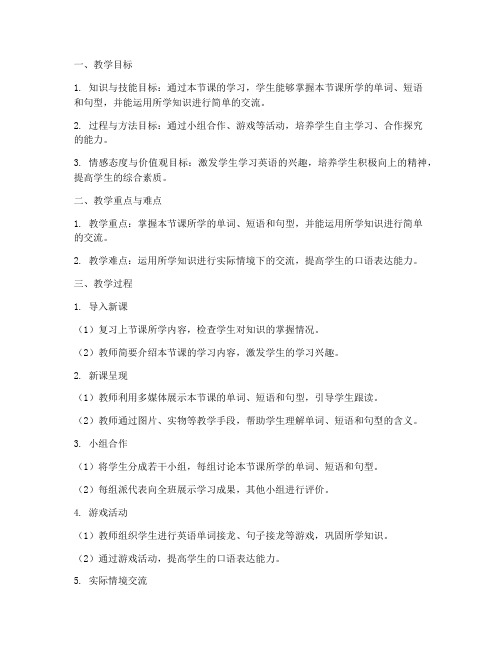
一、教学目标1. 知识与技能目标:通过本节课的学习,学生能够掌握本节课所学的单词、短语和句型,并能运用所学知识进行简单的交流。
2. 过程与方法目标:通过小组合作、游戏等活动,培养学生自主学习、合作探究的能力。
3. 情感态度与价值观目标:激发学生学习英语的兴趣,培养学生积极向上的精神,提高学生的综合素质。
二、教学重点与难点1. 教学重点:掌握本节课所学的单词、短语和句型,并能运用所学知识进行简单的交流。
2. 教学难点:运用所学知识进行实际情境下的交流,提高学生的口语表达能力。
三、教学过程1. 导入新课(1)复习上节课所学内容,检查学生对知识的掌握情况。
(2)教师简要介绍本节课的学习内容,激发学生的学习兴趣。
2. 新课呈现(1)教师利用多媒体展示本节课的单词、短语和句型,引导学生跟读。
(2)教师通过图片、实物等教学手段,帮助学生理解单词、短语和句型的含义。
3. 小组合作(1)将学生分成若干小组,每组讨论本节课所学的单词、短语和句型。
(2)每组派代表向全班展示学习成果,其他小组进行评价。
4. 游戏活动(1)教师组织学生进行英语单词接龙、句子接龙等游戏,巩固所学知识。
(2)通过游戏活动,提高学生的口语表达能力。
5. 实际情境交流(1)教师设置实际情境,让学生运用所学知识进行交流。
(2)教师巡视指导,纠正学生的发音和语法错误。
6. 总结与反馈(1)教师对本节课所学内容进行总结,强调重点和难点。
(2)学生进行自我评价,教师给予评价和反馈。
四、教学评价1. 课堂表现:观察学生在课堂上的参与程度、合作能力、口语表达能力等。
2. 作业完成情况:检查学生课后作业的完成质量,了解学生对知识的掌握程度。
3. 定期测试:通过单元测试、期中考试、期末考试等方式,评估学生的学习成果。
五、教学反思1. 教学过程中,关注学生的个体差异,因材施教。
2. 创设生动有趣的教学情境,激发学生的学习兴趣。
3. 注重培养学生的口语表达能力,提高学生的综合素质。
英语国赛教案模板范文初中
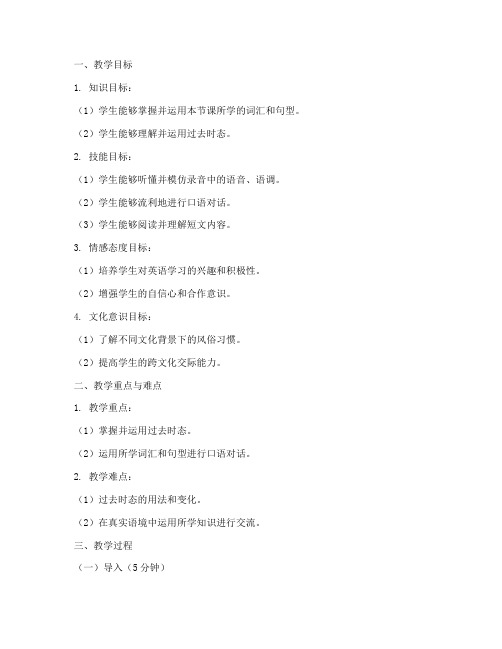
一、教学目标1. 知识目标:(1)学生能够掌握并运用本节课所学的词汇和句型。
(2)学生能够理解并运用过去时态。
2. 技能目标:(1)学生能够听懂并模仿录音中的语音、语调。
(2)学生能够流利地进行口语对话。
(3)学生能够阅读并理解短文内容。
3. 情感态度目标:(1)培养学生对英语学习的兴趣和积极性。
(2)增强学生的自信心和合作意识。
4. 文化意识目标:(1)了解不同文化背景下的风俗习惯。
(2)提高学生的跨文化交际能力。
二、教学重点与难点1. 教学重点:(1)掌握并运用过去时态。
(2)运用所学词汇和句型进行口语对话。
2. 教学难点:(1)过去时态的用法和变化。
(2)在真实语境中运用所学知识进行交流。
三、教学过程(一)导入(5分钟)1. 教师播放一段与课程主题相关的英语歌曲或视频,激发学生的学习兴趣。
2. 引导学生回忆已学过的时态知识,为新课的讲解做好铺垫。
(二)新课讲解(20分钟)1. 教师用PPT展示过去时态的构成方法,并结合例句进行讲解。
2. 学生跟读例句,模仿教师的发音和语调。
3. 教师引导学生分析过去时态的用法,并通过练习巩固所学知识。
(三)课堂活动(15分钟)1. 小组合作:学生分组,每组选择一个场景,运用过去时态进行对话。
2. 教师巡回指导,纠正学生的发音和语法错误。
3. 各组展示对话,全班评价。
(四)阅读理解(10分钟)1. 教师分发短文,学生阅读并回答问题。
2. 教师讲解短文中的重点词汇和句型,帮助学生理解短文内容。
(五)总结与作业(5分钟)1. 教师总结本节课所学的知识,强调重点和难点。
2. 布置课后作业:学生完成课后练习题,巩固所学知识。
四、教学反思1. 本节课是否达到了教学目标,学生是否掌握了所学知识。
2. 教学过程中是否关注到学生的个体差异,是否给予了充分的指导。
3. 课堂活动的设计是否合理,是否激发了学生的学习兴趣。
4. 教学过程中是否存在不足,如何改进。
五、教学资源1. 教材:人教版初中英语教材2. PPT:教学课件3. 录音:英语听力材料4. 短文:阅读理解材料通过以上教学设计,旨在培养学生的英语综合运用能力,提高学生的英语水平,为参加国赛做好充分准备。
初中英语七年级教案一等奖

初中英语七年级教案一等奖《初中英语七年级教案一等奖》这是优秀的教案文章,希望可以对您的学习工作中带来帮助!1、初中英语七年级教案一等奖Unit3. Why do yu like koalas?The first periodⅠ.Teaching Aims and Demands1.Knowledge Objects.1)Key vocabularykoala tiger elephent.dolphin panda lion penguin giraffe zoo cute map smart2)Target languageLet’s see the pandas.Why do you like see the tigers?Because they are cute.2.Ability Objects:1)Train students’abilities of listening and speakng.2) Enable and help the students to learn how to listen to and talk about animals.3.Moral Object:It is very important for everyone to love the nature and protect animals .The earth is our home and animals are our friends..It is our duty to love the nature and protect enviroment.Ⅱ Teaching Key and Difficult Points1)Describe the animals using the words and the target language.2)Get students to learn “Why questions”, “Because answers” and the adjectives of quality.Ⅲ.Teaching methods1)Watching and describing methods2) Oral practicing method.Ⅳ.Teaching Aids:1)objects and some pictures.2)A recorder and computerⅤ.Teaching proceduresStep1.Warming up1) Play the tape,get the students to listen to music of animals2) Play a guessing game.T: Listening to the voices of animals.What kinds of animals are they?3) Show some pictures about animals after guessing and talk about animals.T: Look,there is a big zoo in our city There are many animals init.Do you want to see the animals in the zoo?Let’s go into thezoo.What kind of animals can you see?Step2.Present the new words1) T: Look. What is this in Chinese?Ss:“考拉”T: What is this in English?Do you know?Ss: NoT: It is a koala. Read after me K-O-A-L A, koala.2)Show some new words in the pictures.and teach students to learn them.:koala tiger elephent.dolphin panda lion penguin giraffezoo cute map smartStep3. Practice the new words(1a)1)Get students to read the words in 1a2)Match the words with the animals in the oictures.3)After that check the answers.Step4. Task1) Look at the pictures of animals and describe the animals like this. T: Let’s see the pandas .Do you like them?S1: Yes.I like them very much.T: Why do you like them?S1: Because they are cute .Let’s see the lions.T: Why do you want to see the lions.?S1: Because they are smart.T: Do they live on the land or in the water?S1: They live on the land.(At the same time,Teach the students the words,smart,cute)2)Get students to come up wth more new adjectives of quality to describe the animals.cute, smart, fun, interesting, scary, shy, lazy.(At this time,we can also let the students have a competition.This method can make the students active in class and it can help them develop their quick response and wide thinking)3)Get students to ask and answer in pairs to descibe the animals.4)Get students to performin in front of the class.Step5. Listening1)Play the tape,get students to listen and check.the animals in 12)Play the tape again.Ask students to work in pairs.Students listen and repeat after the recording3)Check the answer.Step6. Pairwork1)Ask the students to make conversations in pairs. Show the followng.A:Let’s see the elephant.B:Why do you want to see the elephant?A:Because they are very smart.(T:Now please make conversations in pairs ,using the animals in Activity 1c.You can have a competition and let’s see which pair of students is the best?)2)Get a few pairs to show their conversations.Step7 SummaryToday we have learnt lots of new words of animals,and the target language.We can describe the animals and other things using the target language.Now,We should remember the earth is our home and animals are our friends. It is our duty to protect animals and love the nature. Step8 Homework.1)Make a survey:What animals do you like?why?2)Write them down and make a conversationVI Blackboard design2、初中英语七年级教案一等奖一、教材分析:本课是冀教版小学英语(三年级起始版)第四册第三单元(All about me)的第4个新授课,Lesson16:How do you go toschool?经过一年半的学习,四年级下学期孩子们学习的重点逐渐过渡到各种基本句型。
全国英语教师赛课一等奖英语七年级上册(人教2024年新编)《Unit4-SectionB》教学设计

基于课程标准的“教-学-评”一致性课堂教学设计科目英语授课教材人教版七年级上册授课题目Unit 4 My Favourite SubjectSection B (1a-2b)课时课型第1课时阅读课主题情境学校生活授课教师语篇研读【What】本篇文章是网络留言板上的两篇帖子。
主要介绍了迈克和吴彬彬最喜欢的学科及理由。
两篇帖子描述了两位不同国籍的学生对自己学习生活的介绍,包括所学的科目、喜欢的科目及其原因,以及对未来的职业规划。
【Why】两篇帖子通过介绍两位来自不同国家的学生所喜欢的学科、喜爱原因以及未来的职业规划。
【How】通过介绍不同国家学生所要上的课程,体现不同国家的文化差异,增强学生的跨文化理解,培跨文化交际意识和能力。
学情分析通过前面课时的学习,学生能够简单地介绍自己所喜欢的科目及其原因。
但是学生对于其他国家的课程设置了解不多,缺少跨文化意识。
同时,学生不能够深入地表达自己对于不同学科的看法以及相关原因,也缺少对未来职业的规划。
课标要求1.理解网络新媒体留言板语篇的主要写作目的、结构特征、基本语言特点和信息组织方式,并用以描述自己和他人的经历;2.理解说明文语篇的主要写作目的、结构特征、基本语言特点和信息组织方式,并用以说明事物和阐释事理;3.理解常见应用文语篇和其他常见语篇类型的主要写作目的、结构特征、基本语言特点和信息组织方式,并用以传递信息;4.在语篇中辨识并尝试运用衔接和连贯手段,以提升理解的准确性和表达的逻辑性。
教学目标通过本节课学习,学生能够:1.有效运用阅读策略获取关键信息,了解发帖人的身份、喜欢的学科及原因。
2.通过使用思维导图总结两篇帖子的语篇结构和内容要点。
3.谈论不同学科的价值和意义,对自己未来的职业有初步的设想。
4.能够灵活运用所学的话题词汇与目标句式描述自己喜爱的学科,并陈述具体原因。
教学重难点学习重点:1.有效运用阅读策略获取关键信息,了解发帖人的身份、喜欢的学科及原因。
- 1、下载文档前请自行甄别文档内容的完整性,平台不提供额外的编辑、内容补充、找答案等附加服务。
- 2、"仅部分预览"的文档,不可在线预览部分如存在完整性等问题,可反馈申请退款(可完整预览的文档不适用该条件!)。
- 3、如文档侵犯您的权益,请联系客服反馈,我们会尽快为您处理(人工客服工作时间:9:00-18:30)。
.教学基本信息课题Unit 1 How do you study for a test?Section B 2a2b, 3a学科英语学段:九年级上册年级初二年级注重学生语言习得的过程,新课标初中英语阅读与写作联动教学法的课堂相关实践领域教材书名:新目标英语Go for it!:人民教育出版日期:2005 年 6月教学设计者的基本信息单位联系方式设计者一零一中学指导思想与理论依据笔者自 03 年 9 月以来,根据新课标初中英语教学的要求和现状,一直在探索与总结归纳一种将阅读与写作有机结合起来的联动教学方法。
这种教学法的核心是:先对学生进行阅读理解的教学,并将其作为写作的基础,在阅读理解的基础上,马上进行同步的写作教学。
同时,以写作教学的结果(学生写作的文章),作为阅读理解教学效果的检验,从而达到阅读教学与写作教学的联动,促进学生英语综合能力的提高。
读写联动教学法的主要理论依据有:多元智能理论、建构主义、过程写作和人本主义。
其中人本主义是强调发挥学生主观能动性的快乐学习;建构主义强调学生在学习中的主体地位;多元智能强调尊重学习者的个体差异和充分利用优势智能的迁移,特别是将阅读理解中的成果直接迁移到写作教学中,作为写作的基础,从而大提高了写作教学的起点水平;过程写作强调写作学习应当成为一种有意图、有意义的学习活动,强调写作学习是一个渐进的过程,侧重点应在注重篇章结构、语法、词汇同时,加强对写作容及写作过程的关注。
相对于大学的阅读与写作联动教学而言,初中阶段必须考虑学生的智能的发展特征,因此尊重学生学习的主体地位,诱导学生多项智能的发展,引导学生优势智能的迁移是高效完成阅读与写作联动教学法的前提和根本目的。
基于这种理论有以下成绩:主要成绩:在此思路指导下设计的《新目标英语七年级(下)第 6 单元》示课,获2004 年全国第七届主体教育学术研讨会“求索杯”课堂教学一等奖。
主要论著:07 年 1 月,撰写的论文“初中英语阅读与写作联动教学法初探”,获市第四届基础教育英语教与学展示活动优秀论文评选一等奖。
05 年 10 月在市基础教育课程教材改革实验工作中成绩突出,获表彰证书。
在此期间,由电力出版了初一初二词汇小伴侣(新目标版和外研社版共四本,笔者任主编)教学背景分析教学容: Unit 1 How do you study for a test? Section B 2a2b, 3a 【学情分析】学习风格与特点:我的教学对象 - 一零一中学初二实验班。
他们英语起点较高,接受能力非常强;具有良好的学习习惯;有强烈的用英语表达的欲望;喜欢课堂环节紧凑、有序;喜欢合作学习。
但是也有一小部分学生学习很努力,但是效果与付出不成正比,通过初步诊断,显然是学习方法不当,学习信心有所不足。
作为初二年级第二学期学生,在开学第二周,老师和学生一起探讨学习英语的困难和方法,有着实际意义。
学生比较习惯我所采用的注重语言习得的过程,以学生为主体,以教师为指导的教学模式。
突出听读领先,读写联动的教学模式。
【教材分析】由人教社出版的《新目标》初中英语教材编写特点是每个单元分为Section A 和Section B 两部分。
Section A 部分是基本的语言容, Section B 部分是知识的扩展和综合的语言运用。
每个单元还附有 Self Check 部分,学生用来自我检测本单元所学的语言知识。
【单元分析】本单元的主要话题 (Section A) 是谈论英语学习方法,涉及了学生较为熟悉的自己学习英语的经历。
例如学生在七年级上( Unit12 Which subject do you like best? )学过喜欢哪个科目及理由。
而本节课 Section B 2a2b,3a 主要谈论学生学习英语的困难和为他人提供学习英语的建议。
有关谈论困难和问题、提建议方面的句型在八年级上(Unit 2 What ’s the matter? )和八年级下( Unit 2 What should I do? )中学过一部分。
【教材整合】在学习了八年级下( Unit 2 What should I do? )后,我将就初三年级上的本课容调整到初二下学期来学。
本单元正是把以上学过的句型融入到新的话题中,并补充新的有关提建议的句型和表示学习方法的词汇、短语。
从而进一步达到将所学英语运用到实际.生活之中,探讨学习英语过程中的困难和改进措施。
本节课我将阅读文章3a 的结尾去掉,让学生通过阅读,根据作者的实际,把握作者的态度,写一个结尾,这样既能训练阅读技能,又能为写作做准备,使学生能写出篇章结构结尾好、主题突出的文章。
我想教材分析方面主要是依据以人为本,为学生的发展提供服务;体现的是用教材教,不是教教材的新课程标准精神。
【本课时分析】通常一个单元分为四个课时处理(Section A两个课时;Section B两个课时),我校与海淀区兄弟学校的课时安排基本一致。
但是由于我所教的学生起点比较高,我在每个单元的教材处理上进行了适当的删减与补充,使教学容更丰富,满足学生的需求。
本节课在教材的使用上进行了一些调整,例如:课本中的reading 和 writing 容对我的学生来讲略显单薄, reading 还不能满足学生writing 的需要。
于是进行了适当的补充和改变(见附件学案)。
所以设计思路为:通过听力学习本课的重点句型,利用阅读篇章来巩固所学的语言知识,培养学生一定的听力和阅读能力;通过补充阅读扩展话题的交际能力,能够口头和书面表达学习英语的困难,并能运用所学句型和学习英语的方法为他人提供建议。
【设计思路】基于以上分析,总的方针是根据学生实际情况,遵循学生身心发展的普遍规律,按照学生认知水平和能力,从学生实际生活经验出发,由易到难,逐级铺设台阶,合理使用教材、安排教学容,注重学生学习英语的过程,本课强调学以致用,通过设置真实情境,在课堂上为学生“架起课堂与实际生活的桥梁”,“系起课堂与外国文化的纽带”。
即我在教学过程中必须围绕特定的交际目的和语言项目,设计出可操作性强的、任务化的,在保持学生学习兴趣的同时,提高课堂学习的效率。
突出学生为主体的教学活动,使学生通过多种课堂学习方式,运用一定学习策略,最终完成系统的任务链,达到学习语言和掌握语言的目的。
在03 年我的学生第一次学习《 Go for it 》这套教材的时候,我明显感到教材为他们提供的输入信息较少,学生无法按要求完成最终写作任务,这样就需要我们教师就为他们选择一些补充容,增加输入量。
在选择补充容的时候,我们既考虑到学生们的认知水平,又考虑到英语语言学习的特点,还要注重学生学习语言的过程,因此我为学生们选择了侧重听说能力培养的 ---Let ’s talk in English! 和 Studio Classroom 月刊和侧重阅读能力培养的《阅读 365 天》《读写方略》《英语晨读精华》中题材丰富、体现英语国家文化的文章。
从七年级开始我校每个单元都会为学生补充一些词汇、英语诗歌、励志谚语、英语歌曲、与作文话题相关的原汁原味阅读文章。
《Go for it !》教材从八年级下开始,难度稍微有所加深,具体体现在输入量较大、语法项目较多、词汇量较大。
九年级的教材除具有以上特点外,还增加了篇幅较长的补充阅读。
这对于我校的学生们来说,也是具有一定挑战性的,但因为从七年级开始,他们的英语学习资源就有了很多的补充,因此九年级教材难易适度。
现行初中英语新目标“Go for it ”,在每个单元都有一个话题写作的容,但相关的阅读材料只有几行,大约 150 词左右。
远远满足不了学生的阅读需求,更谈不上写作参考。
根据我所摸索的阅读写作联动教学法:这一阶段就是要根据教材中阅读材料的不足,有意识地按照阅读理解教学的训练要求和方法,给学生们补充一些课外阅读和一些拓展训练来完成写作教学的这一工作,从而实现写作话题与阅读材料的联动。
设计流程图为了达到在本节课学生能够准确地用所学的语言知识,口头笔头谈论他们英语学习中的问题、并能给予他人一些学习方法的建议这一教学终极目标,我采用了听力、阅读(语言输入)的方式,通过谈论学习困难和提供建议的活动和给他人回信提建议的方式(语言输出),提高学生在真实的情景下运用语言进行交际的能力。
.口头听力表达材料输出一输入一课内输出四阅读输入二学习主体综合听说回答学生课内阅读补充阅读输入输出二相关问题综合写作练习输出三回答相关问题说明:输入三与听说内容相关的补充阅读材料。
一、输入与输出一、二为传统教学过程;输入与输出三、四为读写联动后增加的教学过程。
从学习信息过程分析,增加了2个,同时信息输入与输出的强度大大增强。
二、教学实录片段是为了集中反映教学过程的中的读写联动。
本节课的设计思路话题:谈论学习英语的困难和为他人提供学好英语的建议。
语言知识:学习表达谈论自己在学习英语上的问题以及提供建议的句型。
教学重点:学会用所学目标语言谈论学习英语的困难和为他人提学好英语的建议。
教学难点:用所学目标语言,以口头和笔头的形式,针对实际情况,表达学习英语的困难并为他人提供学好英语的建议。
教学目标:终点能力 ----即通过本节课的学习学生能够达到的目标:1.学生能够听出、读出有关他人在学习英语上的问题以及解决办法的听力材料和阅读文章。
2.学生能够运用所学句型表达自己在英语上学习的困难以及为他人提供解决问题的建.议。
过程与方法:1.注重学生的学习句型的过程,启发学生发散思维,深入思考问题。
2.引导学生在阅读篇章的过程中,快速获取关键信息、分析和处理关键信息。
情感态度:1.同学之间互相帮助、互相鼓励、互相学习,渗透德育教育。
2.了解学习英语的方法并用所学知识去帮助他人解决实际问题。
教法与学法:1.教法:任务统领整节课的教学过程;以旧带新,建立联系及时设置巩固、反馈环节;读写联动将句型结构、功能和话题紧密结合。
2.学法:通过听和读文章了解谈论有关他人在学习英语上的问题以及解决办法的句型;以旧联新,重新组织和完善所学到的语言知识;在学习过程中,通过同伴、同学交流、合作、探究,感知、体验、运用目标语言。
教学资源:自制 ppt 课件;录音机、电视;学案.教学目 (容框架 )一、TopicShowing problems and giving advice on how to learn English well.二、体目 (Objective)本通听写的堂学,注重学生言得的程,在运用中化所学知。
In modern society, English, as a language, is for communication. The students must be required to open their mouth to speak English. I emphasize on bringing the real life situation and exerting imagination for the students to manipulate newly understood language. My activities are designed to help the students use“classroom”strategies to communicate and access their “real world ”.三、教学目 (Teaching Aim)Learn to use the target language to express one’s problems in learning English and give other students some advice on how to learn English well.四、言功能( Function )Use the sentence structures about showing problems to express one’s problems in learning English.Use the sentence structures about advice to give other students some advice on how to learn English well.五、言目( Target Language )Showing Problems:Giving Advice:I have trouble learning English.Listening can help.I forget a lot of new words.Why don ’tyou borrow the tapes?I don ’t understand what people are saying.You can listen to them and repeat ⋯I can ’tget the pronunciation right.Why don ’tyou join an English club?I don ’t get much writing practice.Maybe you should find a pen pal.六、重点 (Key Vocabulary)trouble, pronunciation, sentences, forget, understand, practice七、学策略思技巧 (Learning Strategies)Provide a comprehensive review of related listening skills.Provide a comprehensive review of related reading skills.Set the scene to encourage students to practice the target language.八、言再 (Sentence Structure Recycling )1.Why not do sth⋯?2. Why don ’t you do sth?3. You’d better ⋯4.You should...九、多元智能 (Multi-intelligence)Enjoy the English songs, enjoy learning English. Develop students ’interests in learning English.Develop a better understanding between the teachers and the students.And develop the students ’attitude towards the difficulties in life.十、教学用具 (Teaching Aids)1. Recorder2. Multi-media3. TV4. Blackboard5. Students ’work sheet教学程一、 Lead in :1.Flash 入:学生主体参与是在教学境条件下的一种特殊活,是一个生互的程,一程若配合得当,能使学生极主地参与堂学,使英教学达到事半功倍的效果。
